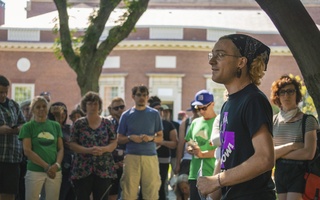{shortcode-5c9402f16b8f50bde9b94bfcf86af392712d9f02}
Harvard Medical School affiliates who worked at Massachusetts General Hospital in the years after the hospital cemented ties with Purdue Pharma — manufacturer of the addictive painkiller OxyContin — say they perceived the company’s influence as minimal at the time.
A lawsuit filed by Massachusetts Attorney General Maura T. Healey ’92 against Purdue in June 2018 alleges the company and its top executives knowingly deceived the public about the risks of OxyContin. Purdue allegedly attempted to influence doctors, residents, and medical students at MGH through donations to the hospital from 2002 through at least 2011, according to a memorandum filed by Healey’s office Jan. 15.
Purdue’s executives — among whom are members of the wealthy Sackler family — targeted MGH in particular due to its prominence and past propensity to prescribe OxyContin, the filing alleges. The company contributed $3 million to a pain program in its name at MGH and at least another $500,000 in additional donations.
“[Purdue] staff told the Sacklers that the Massachusetts General Hospital Purdue Pharma Pain Program gave Purdue name recognition among medical students, residents, and the public, as well as political protection against efforts to address the opioid crisis,” the filing reads.
But according to more than 30 former medical students who spent time at the hospital between 2003 and 2010 — many of whom went on to work as residents and physicians at MGH after graduating — Purdue’s attempts to curry favor with hospital staff did not appear to have any tangible effects. Most said they did not feel Purdue’s presence at all, and some praised safeguards in place at the hospital designed to prevent pharmaceutical companies from possessing undue influence over hospital activities.
As part of their training, Medical School students regularly cycle through the University’s 15 teaching hospitals, including MGH, to gain experience.
Joseph W.T. McQuaid, a urologic surgeon who graduated from the Medical School in 2009 and then stayed on at MGH as a resident until 2015, said he never felt “pushed” to prescribe a particular narcotic while at the hospital, and treatment decisions largely hinged on the patient’s individual needs.
“In urologic surgery, which is my specialty, we use a lot of narcotics and certainly are prescribing them frequently, and not once in my training did I ever hear about any of this,” he said. “I never experienced any pressure to prescribe a certain type of a narcotic as a trainee.”
Other former students said that though the medical community did not yet fully grasp the dangers of long-term high-dose opioid use at the time, policies at MGH and the Medical School shielded them from feeling Purdue’s efforts to promote its narcotic to doctors and Medical School students.
“As a student, I remember MGH doing a good job of insulating us from any pharma influence, and don't recall being exposed to any pharma companies,” Anthony D. Sung, a 2008 HMS graduate, wrote in an email.
Purdue began selling OxyContin in 1996, and prescriptions of the drug soon exploded, producing over $1 billion annually in revenue for the company. But in 2007, Purdue settled with the United States Department of Justice for roughly $600 million for misleading doctors, patients, and regulators about the narcotic’s risk of addiction and potential to be abused. The company pledged at the time to change its practices.
But last week’s memorandum alleges that Purdue’s deceptive behavior continued after that settlement, leading to the deaths of hundreds of Massachusetts residents.
A key element in the company’s strategy, according to the filing, was donating large sums to leading hospitals and universities, including MGH and Tufts University.
Though Healey portrays the Purdue Pain Program and other donations to MGH as a beneficial investment for the pharmaceutical company, the reality is more complicated, according to O’Neil Britton, chief medical officer at MGH.
Britton says the hospital’s relationship with Purdue faltered after an MGH researcher — using funds from Purdue — published a “sentinel” study in the New England Journal of Medicine highlighting the dangers of prescribing high-dose opioids for non-oncological pain management.
Robert Josephson, a spokesperson for Purdue, did not directly refute Britton’s account, referring only to a previous statement from the company.
“Purdue’s led industry efforts to combat prescription drug abuse, which has included collaborating with law enforcement, funding enhancements and improvements to state prescription drug monitoring programs and directing health care professionals to the CDC’s Guideline for Prescribing Opioids for Chronic Pain,” Josephson wrote.
As deaths from prescription painkillers — as well as heroin and other synthetic drugs such as fentanyl — increased exponentially and quickly grew into a national crisis, the consensus among doctors has evolved. Whereas physicians used to commonly prescribe opioids for chronic pain, these drugs are now largely reserved for patients with cancer, in hospice, or recovering from a serious surgery.
In order to reduce the risk of improper pressure to prescribe, MGH officials have sharply limited the ability of pharmaceutical companies to meet with doctors and medical school students in the past ten years, according to Britton.
“We have gone from probably an open-door policy to a very closed-door tight-knit process,” he said.
Britton said Purdue’s attempts to fund MGH research are not inconsistent with the behavior of other pharmaceutical companies, especially when dealing with highly-regarded hospitals such as MGH, where studies carry disproportionate weight in the medical community.
“From their standpoint, when there is good news around a trial, and when it comes from a prominent place, where everyone considers that place to have great scientific integrity, it’s a boon for them,” he said. “It’s a publicly traded company, they announce successful trials all the time, and with a shared brand, around a Harvard institution or Stanford or any other big hospital, it’s a big boon for them.”
— Staff writer Jonah S. Berger can be reached at jonah.berger@thecrimson.com. Follow him on Twitter @jonahberger98
Recommended Articles
-
 Photographer Asks Harvard to Shun Sackler Donations
Photographer Asks Harvard to Shun Sackler Donations -
Harvard's Sackler DilemmaWe believe historical clarity is necessary before coming to a firm decision about the foundation’s moral culpability and Harvard’s decision to accept its funds.
-
 Harvard Medical School Caps Off Capital Campaign with $789 Million
Harvard Medical School Caps Off Capital Campaign with $789 Million -
 Harvard Says Amnesty Policy Will Be In Effect at Harvard-Yale Game
Harvard Says Amnesty Policy Will Be In Effect at Harvard-Yale Game -
 Activists Call on Harvard to Strip Art Museum of Sackler Name
Activists Call on Harvard to Strip Art Museum of Sackler Name













